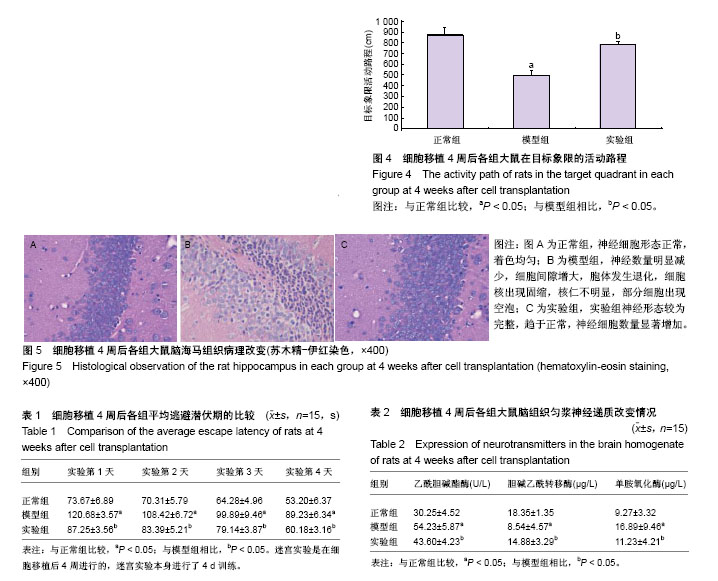| [1] Yilmaz U. Alzheimer's disease. Radiologe. 2015;55(5): 386-388. [2] Alberici A, Benussi A, Premi E, et al. Clinical, genetic, and neuroimaging features of early onset alzheimer disease: the challenges of diagnosis and treatment. Curr Alzheimer Res. 2014;11(10):909-917.[3] 黄维,马晶,晁凤蕾,等.氟西汀通过增加阿尔茨海默病APP/PS1转基因小鼠脑内乙酰胆碱的含量改善其空间学习能力[J].中国组织化学与细胞化学杂志,2017,26(1):29-35.[4] Bhattacharya S, Montag D.Acetylcholinesterase inhibitor modifications: a promising strategy to delay the progression of Alzheimer's disease.Neural Regen Res. 2015;10(1):43-45.[5] 杨青云.神经生长因子联合盐酸多奈哌齐治疗阿尔茨海默病的疗效及对血清炎性因子水平的影响[J].中国实用神经疾病杂志, 2016,19(9):8-10.[6] 张瑜.淫羊藿、黄芪、葛根有效成分组方对阿尔茨海默病脑铁超载的干预作用及其机制研究[D].石家庄:河北医科大学,2016.[7] 钱钧强,叶因涛,王冬,等.白藜芦醇治疗阿尔茨海默病的研究进展[J].现代药物与临床,2016,31(6):924-928. [8] 俞书红,吕秋石,郭志良,等.5-HT6受体拮抗剂SB271046对大鼠癫痫后认知功能障碍的作用[J].医学研究生学报, 2016,29(12): 1265-1269.[9] 段晓宇,张正春,蔡秀英,等.尼莫地平对阿尔茨海默病大鼠认知功能的影响[J].苏州大学学报(医学版),2012,32(50):645-648.[10] 白玉涵,于丽君.药物治疗阿尔茨海默病认知功能障碍疗效的研究进展[J].现代养生(下半月版),2017,17(12):74-75.[11] 关运祥.综合疗法治疗阿尔茨海默病临床研究[J].亚太传统医药, 2017,13(6):113-114.[12] Hui S, Yang Y, Peng WJ,et al.Protective effects of Bushen Tiansui decoction on hippocampal synapses in a rat model of Alzheimer's disease.Neural Regen Res. 2017;12(10): 1680-1686.[13] 赵小芳,钱冰,王静,等.CaMKII反义寡核苷酸对阿尔茨海默病样大鼠海马细胞损伤的保护作用及其机制[J].西安交通大学学报(医学版),2017,38(1):13-17.[14] 贺小松.Aβ(1-40)和192-IgG-saporin致阿尔茨海默病动物模型的构建[D].广州:广州医科大学,2010.[15] 张玥,罗俊,黄能慧,等.灵芝三萜类化合物对AD大鼠脑海马神经细胞Aβ1-40的影响[J].贵州医药,2016,40(7):681-682.[16] 余研,吴志峰,秦毅辉,等.银杏叶提取物对阿尔茨海默病模型大鼠神经功能的影响[J].中国微侵袭神经外科杂志, 2017,22(6): 275-278.[17] 王晓雯,邓海燕,王健,等.环磷酸腺苷效应元件结合蛋白/脑源性神经营养因子信号通路在调心方改善APP/PS1小鼠学习记忆中的作用[J].中国康复理论与实践,2018,24(1):11-16.[18] 黄强,李琼,韦荔莉,等.parkin对AD转基因果蝇模型的神经保护作用及其作用机制的研究[J].安徽医科大学学报, 2014,49(12): 1735-1738.[19] Song L, Li X, Bai XX,et al.Calycosin improves cognitive function in a transgenic mouse model of Alzheimer's disease by activating the protein kinase C pathway.Neural Regen Res. 2017;12(11):1870-1876.[20] 乔萌,黄欣,何云凌,等.缺氧对稳定表达人淀粉样前体蛋白HEK293细胞的存活及阿尔茨海默病相关蛋白表达的影响[J].中国应用生理学杂志,2016,32(2):106-109.[21] 李林,茹立强.中药丹参酮对复合痴呆大鼠海马内诱导型一氧化氮合酶和乙酰胆碱酯酶的影响[J].时珍国医国药, 2010,21(2): 392-394.[22] Zhu X, Liu Z, Deng W, et al. Derivation and characterization of sheep bone marrow-derived mesenchymal stem cells induced with telomerase reverse transcriptase. Saudi J Biol Sci. 2017;24(3):519-525. [23] Teng ZW, Zhu Y, Na Q, et al. Regulatory effect of miRNA on multi-directional differentiation ability of mesenchymal stem cell in treatment of osteoporosis. J Biol Regul Homeost Agents. 2016;30(2):345-352.[24] Li M, Cai H, Yang Y, et al. Perichondrium mesenchymal stem cells inhibit the growth of breast cancer cells via the DKK-1/Wnt/β-catenin signaling pathway. Oncol Rep. 2016; 36(2):936-944.[25] 卞合涛,郝楼,黄卫.NT-3基因修饰骨髓间充质干细胞移植治疗脑梗死及其机制研究[J].中华神经医学杂志,2017,16(9):906-910. [26] Liew LC, Katsuda T, Gailhouste L, et al. Mesenchymal stem cell-derived extracellular vesicles: a glimmer of hope in treating Alzheimer's disease. Int Immunol. 2017;29(1):11-19. [27] Turgeman G.The therapeutic potential of mesenchymal stem cells in Alzheimer's disease: converging mechanisms.Neural Regen Res. 2015;10(5):698-699.[28] 王慧娴,高晓唯,杨于力,等.胎盘间充质干细胞对角膜缘干细胞干性维持及扩增能力影响[J].中国实用眼科杂志, 2017,35(1): 84-88.[29] 张惠娟,丛姗,梁美萍,等.人羊膜间充质干细胞分离培养:胰蛋白酶及胶原酶消化时间及浓度的选择[J].中国组织工程研究, 2014, 18(6):944-949.[30] 赵刚,刘微微,高伟玮,等.不同组织来源间充质干细胞体外成骨分化能力的比较研究[J].中国骨质疏松杂志, 2017,23(5):561-566, 584.[31] Li DW, He J, He FL, et al. Silk fibroin/chitosan thin film promotes osteogenic and adipogenic differentiation of rat bone marrow-derived mesenchymal stem cells. J Biomater Appl. 2018. doi: 10.1177/0885328218757767.[32] 李清,邹丽影,曾嘉颖,等.全反式维甲酸抑制大鼠骨髓间充质干细胞成脂分化信号通路中Fosl1直接调控PPARγ2[J].中国病理生理杂志,2017,33(6):1104-1111.[33] 王爱梅,未小明,李弋,等.旱莲草对老年痴呆模型大鼠空间学习记忆及海马神经元突触可塑性的影响[J].神经解剖学杂志, 2015, 31(1):73-78.[34] 李钟勇,张鹏.美洛昔康对老年痴呆模型大鼠学习记忆能力及脑组织SOD, MAO-B, MDA的影响[J]中国现代应用药学, 2011, 28(2):99-103.[35] 牟玲燕,沈蒋君,孙爱群,等. Aβ42基因在大肠杆菌中的表达及诱导BALB/c小鼠的抗体产生[J].中华临床医师杂志(电子版), 2014, 8(10):1889-1893.[36] Bazazzadegan N, Dehghan Shasaltaneh M, Saliminejad K, et al. Effects of Ectoine on Behavior and Candidate Genes Expression in ICV-STZ Rat Model of Sporadic Alzheimer's Disease. Adv Pharm Bull. 2017;7(4):629-636. [37] Wu X, Kosaraju J, Zhou W, et al. SLOH, a carbazole-based fluorophore, mitigates neuropathology and behavioral impairment in the triple-transgenic mouse model of Alzheimer's disease. Neuropharmacology. 2018;131:351-363. [38] 王卓,任向前,未东兴.向脑海马区移植骨髓间充质干细胞改善阿尔茨海默病大鼠记忆功能[J].中国组织工程研究, 2014,18(50): 8130-8134.[39] 马刘红,程欣,徐建兵,等.人脐带间充质干细胞对阿尔茨海默病模型小鼠学习记忆能力的影响[J].广东医学, 2012,33(10): 1366-1369.[40] Lykhmus O, Uspenska K, Koval L, et al. N-Stearoylethanolamine protects the brain and improves memory of mice treated with lipopolysaccharide or immunized with the extracellular domain of α7 nicotinic acetylcholine receptor. Int Immunopharmacol. 2017;52:290-296.[41] Asam K, Staniszewski A, Zhang H, et al. Eicosanoyl-5-hydroxytryptamide (EHT) prevents Alzheimer's disease-related cognitive and electrophysiological impairments in mice exposed to elevated concentrations of oligomeric beta-amyloid. PLoS One. 2017;12(12):e0189413. [42] 孙正海,朱家进,孟静文,等.阿尔茨海默病患者脑神经递质变化及分布特点研究[J].中国医学创新,2017,14(14):9-12.[43] 蒙缜之,廖美爱,李婷,等.慢性铝中毒小鼠学习记忆能力与大脑皮层乙酰胆碱和β-内啡肽关系的研究[J].中国现代医药杂志, 2017, 19(4):1-3.[44] 黄维,马晶,晁凤蕾,等.氟西汀通过增加阿尔茨海默病APP/PS1转基因小鼠脑内乙酰胆碱的含量改善其空间学习能力[J].中国组织化学与细胞化学杂志,2017,26(1):29-35.[45] 闫飞.人羊膜上皮细胞移植治疗阿尔茨海默病的实验研究[D].郑州:郑州大学,2010. [46] 李祥生.人羊膜间充质干细胞移植治疗阿尔茨海默病转基因鼠的实验研究[D].郑州:郑州大学,2009. |
.jpg)

.jpg)
.jpg)